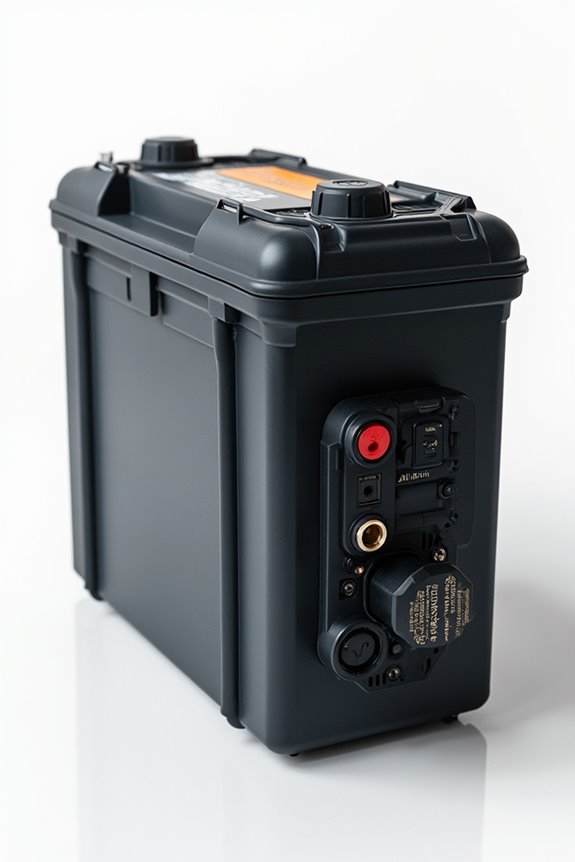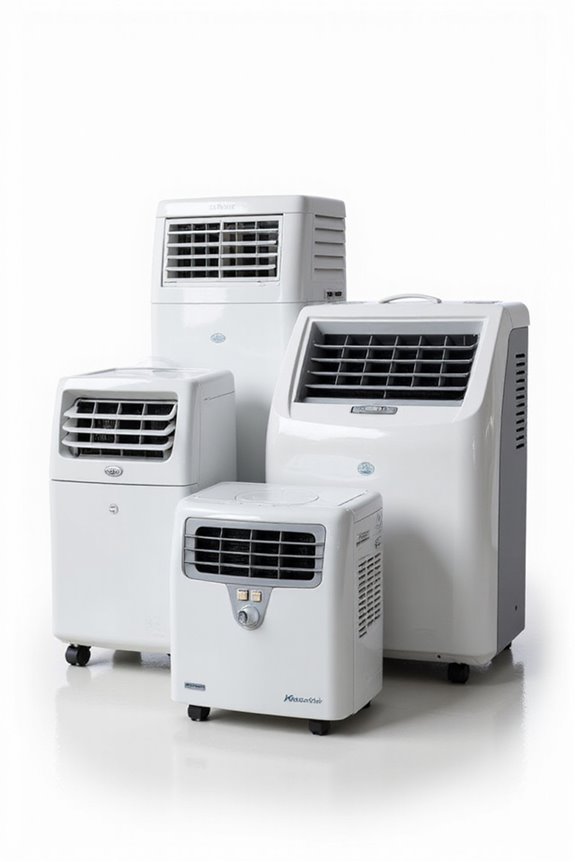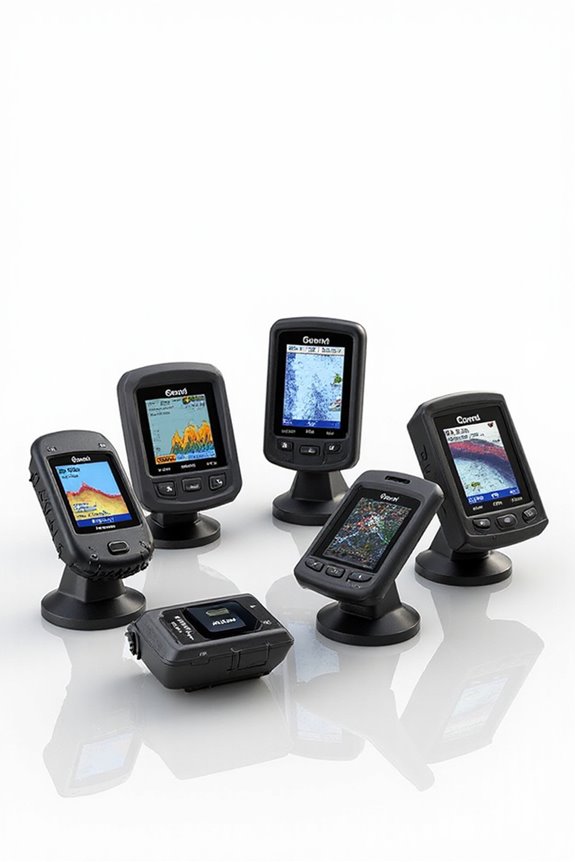As an Amazon Associate, we earn from qualifying purchases. Some links may be affiliate links at no extra cost to you. Although our opinions are based on curated research, we haven't used these products. Articles generated with AI.

The 5 Best Battery Management Systems (BMS) of 2025: Keeping Your Energy Storage Safe and Efficient
When it comes to keeping your energy storage safe and efficient in 2025, you’ll want to check out the Victron Energy VE.Bus BMS, a perfect fit for Victron Smart Lithium batteries. Also, don’t miss the compact 24S BMS for Lifepo4, which excels in tight spots. The HiLetgo 4S is great for various applications, while the 3S board offers solid protection. Finally, the JKBMS with its LCD display keeps you informed. Want to know more about these top picks?
Key Takeaways
- Choose systems like the Victron Energy VE.Bus BMS for enhanced communication and troubleshooting with Victron Smart Lithium batteries.
- Look for compact designs like the 24S BMS for tight installations without sacrificing protection features such as overcharge and short circuit protection.
- Opt for reliable materials and robust protection, as seen in the 3S Lithium Battery Protection Board, to ensure durability and functionality.
- Prioritize BMS with operational continuity features to maintain critical monitoring even during system shutdowns for better battery health management.
- Ensure compatibility with various battery types and configurations to maximize flexibility and safety in energy storage systems.
Victron Energy Version 2 VE.Bus BMS Battery Management System
Victron Energy Version 2 VE.Bus BMS Battery Management System
- New version of BMS designed for use with Victron Smart Lithium batteries
- Upgrades include improved communication with GX device in standalone mode
- BMS can provide power to GX device to facilitate troubleshooting
If you’re on the hunt for a battery management system that’s tailor-made for Victron Smart Lithium batteries, the Victron Energy Version 2 VE.Bus BMS might just be your new best friend. This system amps up communication with your GX device in standalone mode, even giving it power for troubleshooting—talk about convenience! Plus, the remote switch terminal lets you control the system with ease. And don’t worry, if you need to shut down, your GX device stays operational for easy restoration. It’s like having a loyal sidekick for your battery health—who knew energy storage could be this user-friendly?
Best For: Users seeking a reliable battery management system specifically designed for Victron Smart Lithium batteries.
Pros:
- Enhanced communication with GX devices for improved troubleshooting capabilities.
- Remote switch terminal allows for easy system control and management.
- Operational continuity ensures the GX device remains functional even after a system shutdown.
Cons:
- May have limited compatibility outside of Victron Smart Lithium batteries.
- Installation might require specific technical knowledge.
- Initial cost could be higher compared to basic battery management systems.
24S BMS 72V 50A Lifepo4 Battery Management System PCB
Bisida 24S BMS 72V 50A Lifepo4 Battery Management System PCB Protection Board with Balance Wire and...
- MULTIPLE PROTECTION Bisida's BMS has a variety of protection functions, such as over charge protection, over discharge protection, over current protection, short-circuit...
- OPERATING TEMPERATURE Bisida's BMS supports (3.2V) Lifepo4 battery charging and discharging in zones from 2.3V to 3.65V, with low temperature protection up to -20°C and...
- NOTICE Before installing the BMS protective board, it is necessary to match the voltage, capacity, and internal resistance (the voltage difference between the battery per...
Looking for a reliable battery management solution? The Bisidas 24S BMS 72V 50A Lifepo4 Battery Management System PCB might be just what you need! With dimensions perfect for tight spaces, this lightweight board offers excellent protection against overcharge, over-discharge, and short circuits, ensuring your battery stays safe. It even handles temperatures from -20°C to 70°C—talk about versatility! Installation is a breeze, but remember to keep voltage differences in check. Plus, with a customer rating of 4.8 stars, you know you’re getting a trusted product. Why not give your Lifepo4 batteries the care they deserve?
Best For: Those seeking a reliable and versatile battery management system for Lifepo4 batteries.
Pros:
- Multi-function protection features safeguard against overcharge, over-discharge, and short circuits.
- Operates efficiently in extreme temperature ranges from -20°C to 70°C.
- High customer rating of 4.8 stars indicates strong user satisfaction.
Cons:
- Requires careful installation to maintain voltage and resistance specifications.
- Limited compatibility as it is specifically designed for Lifepo4 batteries only.
- Warranty information must be requested, which may complicate the purchasing process.
HiLetgo 14.8V 4S 30A Lithium Battery BMS PCB
HiLetgo 14.8V 4S 30A 18650 Li-ion Lithium Battery BMS PCB Integrated Circuits Protection Board Cell...
- 14.8V 4S 30A 18650 Li-ion Lithium Battery BMS PCB Integrated Circuits Protection Board Cell Balance.
- High-accuracy voltage detection circuit, fine workmanship and durable.
- Working current: 30A .Charging voltage: 16.8V-18V,the best is 17v.Size:56*48*4mm.
The HiLetgo 14.8V 4S 30A Lithium Battery BMS PCB stands out as a fantastic choice for anyone tackling battery projects—especially those working with lithium-ion battery setups. With a working current of 30A and a balanced current of 60mA, it’s quite efficient. You’ll appreciate its robust protection features, including overcharge, over-discharge, and short circuit protection.
But, heads up: you need to apply power to P+ and P- for it to activate. So, no fancy switches, okay? Users have reported mixed reliability under load, but overall, it’s a solid PCB for your 4S, 3P battery packs. Give it a shot!
Best For: Those working on lithium-ion battery projects who need a reliable BMS for 4S, 3P battery configurations.
Pros:
- Robust protection features including overcharge, over-discharge, and short circuit protection.
- Efficient with a working current of 30A and a balanced current of 60mA.
- Compact size (56*48*4mm) and wide temperature range (-20°C to +80°C) make it suitable for various applications.
Cons:
- Requires power to be applied to P+ and P- for activation, limiting switch options.
- Users have reported mixed reliability under load conditions.
- Some initial setup issues, including voltage output challenges.
3S 12V 10A Lithium Battery Protection Board BMS (3 Pcs)
Comidox 3S 12V 10A 18650 Lithium Battery Protection Board BMS Li-ion Charger Protection Module...
- The power range described is applicable to the following products: vacuum cleaner, massager battery pack, LED light backup power supply, 12V electronic products, solar...
- With overcharge, over discharge, over current, short circuit and other protection functions, for a variety of shapes of various shapes 3.7V lithium battery.
- High quality MOSFETs such as VISHAY, AOS, IR, etc., FR-4 low temperature coefficient sheet, well designed and tested.
When you need a reliable battery management system, the 3S 12V 10A Lithium Battery Protection Board BMS stands out as an excellent choice, especially for DIY enthusiasts and those powering everyday devices. This compact board supports various applications, from vacuum cleaners to solar street lights. With its robust protection features—overcharge, over-discharge, over-current, and short circuit protection—you’ll feel confident in your battery’s safety. Built with quality MOSFETs and a sturdy FR-4 sheet, it offers great value. Just remember, it’s not compatible with certain battery packs, so double-check before diving into your next project. Happy tinkering!
Best For: DIY enthusiasts and individuals seeking a reliable battery management system for various everyday devices.
Pros:
- Robust protection features include overcharge, over-discharge, over-current, and short circuit protection ensuring battery safety.
- Compact design suitable for high integration in various applications such as vacuum cleaners and solar street light battery packs.
- High-quality components used in construction, providing durability and reliability.
Cons:
- Not compatible with iron ion polymer batteries and certain electric vehicle battery packs, limiting versatility.
- Usage restrictions may exclude some popular applications like electric bicycles and power-hungry devices.
- Requires careful consideration before use to ensure compatibility with specific battery types.
JKBMS 2 inch LCD Display Screen for JK Smart BMS Battery Protection Board
JKBMS Accessory 2 inch LCD Display Screen with Active Switch Monitor for JK Smart BMS Battery...
- Compact LCD Display: 2-inch LCD with clear visuals, ideal for space-saving, detailed battery info
- Active Switch Control: Real-time system adjustments via display, optimized for JK Smart BMS
- Easy Installation: Compatible with JK BMS systems, includes all hardware and instructions
If you’re a DIY enthusiast or just someone looking to enhance your battery management system, the JKBMS 2 inch LCD Display Screen offers a fantastic upgrade for your JK Smart BMS Battery Protection Board. This compact 2-inch screen fits easily, providing clear visuals on critical data like State of Charge and fault codes. You’ll appreciate the alarms for overcharging or overheating—no more guessing if your battery’s misbehaving! Installation’s a breeze, and the included app support is a nice bonus. Just remember, it goes blank after 20 seconds of inactivity. Still, it’s an essential tool for keeping your battery healthy and happy!
Best For: DIY enthusiasts and individuals looking to improve their battery management system with clear real-time monitoring.
Pros:
- Compact 2-inch design offers clear visuals for monitoring critical battery data.
- Easy installation with included hardware and instructions makes setup straightforward.
- Alarms for overcharging and overheating provide peace of mind and prevent battery damage.
Cons:
- Display goes blank after 20 seconds of inactivity, which may require frequent button presses to reactivate.
- Some users may need a separate 12V power supply for operation, adding to setup complexity.
- Limited customer ratings (3.8 out of 5 stars) indicate a mixed user experience.
Factors to Consider When Choosing a Battery Management System (BMS)

When you’re on the hunt for the perfect Battery Management System (BMS), there are a few key factors you can’t overlook. Think about your desired battery type, the protection features you absolutely need, and how it’ll communicate with other devices—because nobody likes shouting at their gadgets, right? Plus, consider operational continuity and the size and weight to guarantee everything fits like a glove in your setup.
Desired Battery Type
Choosing the right battery management system (BMS) is key to maximizing your battery’s performance, and it all starts with knowing your desired battery type. Are you working with Lithium-ion, LiFePO4, or maybe lead-acid? Each chemistry has its quirks, like voltage and charging needs, which can make or break your choice. You also need to match the BMS to your battery’s configuration—yep, that means keeping tabs on how many cells are in series and parallel. Think about the voltage range too; a 24S LiFePO4 battery demands a BMS that can handle 76.8V. Finally, don’t forget current ratings! Exceed them, and you might just have a thermal meltdown on your hands—yikes! Stay safe, stay smart!
Protection Features Needed
Understanding the protection features you need in a Battery Management System (BMS) is essential for safeguarding your battery and ensuring it performs at its best. First up, overcharge protection prevents lithium batteries from exceeding voltage limits, which keeps you safe and prolongs battery life. Don’t overlook over-discharge protection, either—this feature prevents cells from dropping below critical voltage levels, avoiding irreversible damage. You also want short-circuit and over-current protection to shield against dangerous currents and excessive loads. Finally, let’s talk temperature protection: your BMS should monitor extreme temperatures, ensuring safe operation. Think of these features as your battery’s personal bodyguards—because your energy storage deserves the best defense against potential hazards! So, make sure you choose wisely!
Communication Capabilities
After making sure your battery is safe with solid protection features, the next big thing to contemplate in a Battery Management System (BMS) is communication capabilities. Why? A BMS with strong communication lets you connect with other devices, like GX devices, making troubleshooting a breeze. Ever wanted to check your battery status during a shutdown? Enhanced communication allows monitoring, keeping you in the loop. You’ll receive real-time data on voltage, temperature, and even fault codes, which boosts reliability. Plus, compatibility with various interfaces means you can manage your battery from anywhere—yes, even from your couch! Fault detection alerts are also part of the deal, helping you catch issues before they become big problems. Isn’t that comforting?
Operational Continuity Importance
When it comes to battery management, operational continuity isn’t just a fancy term; it’s a game-changer. Imagine having critical monitoring and diagnostic functions still active, even when your system’s powered down. Sounds pretty handy, right? A BMS that supports operational continuity keeps devices like your GX gadgets running, boosting reliability and user friendliness. Plus, it helps you spot potential battery issues before they lead to serious damage. With ongoing battery health checks, you can react to problems more quickly, enhancing safety. And let’s be honest, who wouldn’t appreciate accessing information without needing to turn the whole system back on? In the end, a BMS with operational continuity makes your energy storage more efficient and hassle-free.
Size and Weight
Choosing the right battery management system (BMS) means considering size and weight carefully—after all, nobody wants their high-tech gadget resembling a brick! A compact BMS, often around 4.92 x 4.92 x 0.39 inches, works wonders in tight spaces, like portable devices and lightweight electric vehicles. Also, weigh the options; some units tip the scales at just 0.81 ounces, while others can weigh over 6 ounces, which can impact your overall system’s portability. For applications such as drones and electric bikes, every ounce counts. A sleek, low-profile design might be essential depending on your installation environment. So, keep dimensions in mind to guarantee your BMS fits seamlessly into your battery setup without making it feel like a clunky, lead-filled brick!
Installation Requirements
Before you plunge into installing a Battery Management System (BMS), it’s essential to contemplate a few key factors to verify everything runs smoothly. First, make sure your BMS is compatible with your battery type—whether it’s Lifepo4 or Li-ion. Don’t forget about the voltage requirements, as mismatched levels can lead to trouble. Also, pay attention to internal resistance and capacity differences; these can dictate performance.
Wiring instructions? Read them like a recipe—mixing up positive and negative connections? Yikes!
Consider the BMS’s size and weight too; you wouldn’t want it to resemble a small elephant in your setup. Finally, confirm it can handle the temperature extremes in your environment. After all, you want your energy storage to stay efficient, right?
Frequently Asked Questions
What Is the Average Lifespan of a Battery Management System?
The average lifespan of a battery management system (BMS) usually ranges from 5 to 15 years, depending on factors like usage and maintenance. You’ve got to remember, though, that keeping it clean and monitoring performance helps maximize its life. Think of it as a car; regular check-ups can really extend its route! So, if you’re looking to optimize your energy storage, investing in a reliable BMS is definitely worth it. Don’t skimp!
How Do I Know if My BMS Needs an Upgrade?
You’ll know your BMS needs an upgrade if you notice inconsistencies in battery performance, like rapid discharges or overheating. If it starts throwing error codes more often than a toddler tantrums, it’s time to pay attention. Check for updates from the manufacturer regularly; they may offer enhancements for efficiency. Also, if your system’s compatibility with new tech is lacking, an upgrade could help you stay charged and ready for action!
Can a BMS Be Used for Solar Energy Storage?
Absolutely, a BMS can be used for solar energy storage! Think about this: over 80% of solar systems can benefit from one. A good BMS monitors battery health, controls charge and discharge rates, and optimizes energy use. Without it, your precious solar energy might as well be taking a nap. You wouldn’t want your batteries to underperform, right? So, investing in a reliable BMS means you’re keeping your solar energy operating smoothly and efficiently!
What Safety Features Should I Look for in a BMS?
When you’re shopping for a battery management system (BMS), keep an eye out for safety features like over-voltage protection, thermal management, and short-circuit prevention. These things help protect your batteries from nasty surprises. Wouldn’t it be a bummer if your whole setup melted down? Plus, features like cell balancing guarantee longer battery life, so you can enjoy your energy storage without worry. Stay safe and keep that energy flowing smoothly!
How Does Temperature Affect Battery Management Systems?
Did you know that battery performance can drop by 20% for every 10°C increase in temperature? That’s a pretty big deal! When temperatures soar, batteries can overheat, leading to reduced efficiency and even safety issues. A reliable Battery Management System (BMS) monitors temperature closely, balancing charge rates to avoid damage. So, if you want your batteries to last longer and stay safe, keeping an eye on that thermostat is essential! Who knew heat could be so dramatic?









